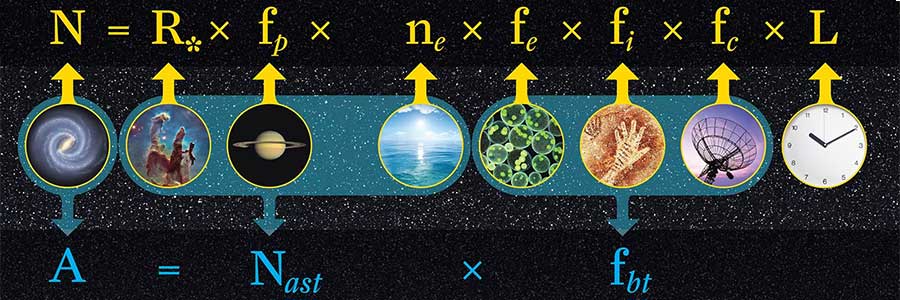Is there life on other planets or are we alone in the universe? Thanks to our “Is there life on other planets” calculator you can easily find out. The calculator uses the Drake equation to estimate how many intelligent, communicating civilizations there are in our galaxy. You can use the standard values or the pessimistic/optimistic ones (see it in the table below) to get an exact answer to one of the most exciting questions.
Is there life on other planets? Calculator
Information about the ‘Is there life on other planets?’ Calculator
“Is there life on other planets?” Calculator is based on the Drake Equation developed by Dr. Frank Drake in 1961. The original goal of the Drake Equation was to stimulate scientific dialogue at the first scientific meeting on the Search for Extraterrestrial Intelligence (SETI) conference and also to justify that the search for life in the Galaxy was not hopeless venture.
Professor Drake proposed the equation to estimate the possible number of civilizations in the Milky Way. The Drake Equation or sometimes referred to as the Drake Formula contains a number of highly uncertain terms—variables that must simply be guessed at—however, it is a very useful way of breaking down a complex question into more readily digestible portions. In addition, some of the variables that were highly uncertain in 1961—the number of stars with planets, for example—are becoming more certain as further research is conducted.
The Drake equation multiplies the number of stars in the Milky Way by the fraction which has orbiting planets, then by the number of planets per star that are capable of sustaining life, then by the fraction of these planets where life actually evolves, then by the fraction of these where the life is intelligent and communicates, and then by the fraction of the planet’s life during which the communicating civilizations live. This represents an estimate of the number of communicating civilizations in the Galaxy. The real value of the Drake equation is not in the answer itself, but the questions that are prompted when attempting to come up with an answer.
How does the Drake Equation look like?
According to SETI.org, here’s what the Drake Equation looks like:
The terms of the Drake Equation are defined as follow:
- N = The number of civilizations in the Milky Way galaxy whose electromagnetic emissions are detectable (which means that communication might be possible via radio signals).
- R* = The rate of formation of stars suitable for the development of intelligent life (number per year).
- fp = The fraction of those stars with planetary systems.
- ne = The number of planets, per solar system, with an environment suitable for life.
- fl = The fraction of suitable planets on which life actually appears.
- fi = The fraction of life bearing planets on which intelligent life emerges.
- fc = The fraction of civilizations that develop a technology that produces detectable signs of their existence.
- L = The average length of time such civilizations produce such signs in years.
| Variable name | Value used by Professor Drake | Optimistic value | Pessimistic value |
|---|---|---|---|
| R* | 1 | 7 | 7 |
| fp | 0.5 | 0.99 | 0.2 |
| ne | 2 | 2 | 0.00001 |
| fl | 1 | 1 | 0.001 |
| fi | 1 | 1 | 0.001 |
| fc | 0.1 | 1 | 0.01 |
| L | 10000 | 1000000000 | 100 |
| N | 1000 | 13860000000 | 1.4E-11 |
The result means the number of civilizations in our galaxy with which communication might be possible, Source: Fandom.com Drake Equation
Perhaps the most important term in the Drake equation is L, the lifetime of a civilization. How long do civilizations capable of communication last? To estimate how many civilizations there are in the Galaxy at any given time, we must know how long they last. Once lit, how long does the candle of civilization (on average) burn? Consider our own civilization, one with a recorded history of no more than 5,500 years and that has been highly technological for less than a century. Planets and stars have long life spans, but we have only a little.
So what is the average life span of a civilization? A thousand, five thousand, ten thousand, a million years? Even if, over time, there have been many, many civilizations in our Galaxy, how many are there now? Traveling to the location of another civilization in the Galaxy is a highly impractical proposition. In the best-case scenario, civilizations in the Galaxy are hundreds of lightyears apart, and getting even to the nearest star would take us (using current technology) tens of thousands of years. The civilization might be long gone by the time we got there.

The Drake equation is a mathematical formula for the probability of finding life or advanced civilizations in the universe. Source: the University of Rochester and Nasa Exoplanet Exploration
As you can see on the image above, Adam Frank and Woodruff Sullivan offered a new equation to address a slightly different question: What is the number of advanced civilizations likely to have developed over the history of the observable universe? This equation draws on Drake’s but eliminates the need for L which, as we discussed above is very difficult to determinate.
Their argument hinges upon the recent discovery of how many planets exist and how many of those lie in what scientists call the ‘habitable zone’ – planets in which liquid water, and therefore life, could exist. This allows Frank and Sullivan to define a number they call Nast. Nast is the product of N*, the total number of stars; fp, the fraction of those stars that form planets; and np, the average number of those planets in the habitable zones of their stars.
They then set out what they call the ‘Archaeological-form’ of the Drake equation, which defines A as the ‘number of technological species that have ever formed over the history of the observable Universe.’ Their equation, A=Nast*fbt, describes A as the product of Nast – the number of habitable planets in a given volume of the Universe – multiplied by fbt – the likelihood of a technological species arising on one of these planets. The volume considered could be, for example, the entire Universe, or just our Galaxy.
So are aliens real? Are UFOs real or are we alone in the universe?
If civilizations last for many millions of years, then our own Galaxy could be teeming not only with life but also with civilizations. If L is rather small (hundreds or thousands of years), then the Galaxy may be a lonely place indeed. Civilizations, like candles, may be lit frequently, but if they do not burn for very long, only a few others will be burning with us. Back to the main questions, it’s very hard to be answered exactly but if we are using a Drake Formula with optimistic numbers we can believe that we are not alone.
As a closing thought, we’d quote from the film Contact (1997), which is a must-see for everyone who is interested in Extraterrestrial Life: “There are four hundred billion stars out there, just in our galaxy alone. If only one out of a million of those had planets, and just of out of a million of those had life, and just one out of a million of those had intelligent life; there would be literally millions of civilizations out there.” – Eleanor Arroway (Jodie Foster)
